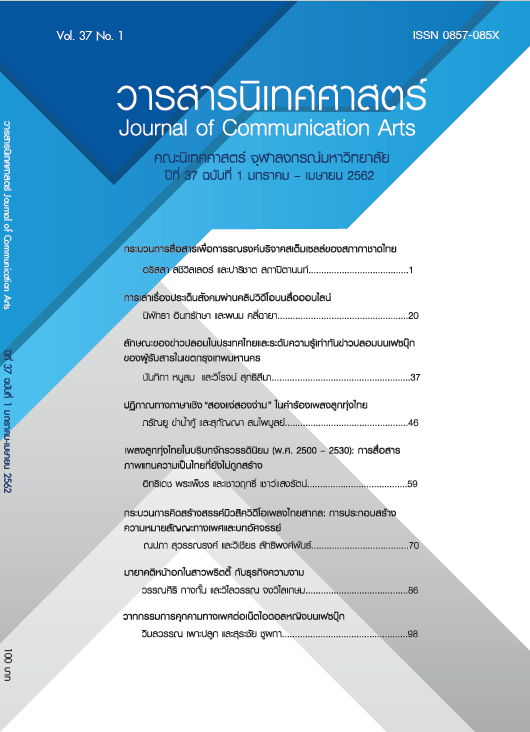The Analysis of Fake News and The Level of Media Literacy of Users in Bangkok
Main Article Content
Abstract
This study aimed to study fake news and the level of media literacy of fake news on facebook of the receiver in Bangkok. This study was quantitative research, it started
with analyzing the content of fake news found on the social network of 30 stories then the classification and content of the fake news. Then was survey the level of seeing through a trick of the recipient in Bangkok and factors that made the audience believe in fake news with 400 online questionnaires. The results of the research were as follows: 1) fake news which was mostly found was bogus, the most found of content was fabricate content. The intent was to create a complete fake news all content was freshly invented, including images, headlines, content and information appearing in the news. This method of creating complete fake news was a method developed from a click bait because the recipients were seeing through a trick of click bait. Fake news presenter has changed the presentation format in order to make readers cannot know the trick. 2) The level of media literacy of the receiver in Bangkok was at middle level considering each level, Access, Analyze, and Evaluate were at a high level. All three skills were essential skills for the media consumers, at the level of creativity; the media had the lowest level of creativity in the media. 3) It was found that the composition of the news that made the sample very trustworthy was the news that celebrity sources were famous. The other factors that made the news reliable, for high level was the news often presented on the facebook’s news feed and news that readers could always find reasons to support their beliefs.
Article Details
References
ใจดี โลกสวย เชื่อคนง่าย!!! คนไทย 40% เชื่อข่าวปลอมบนโซเชียลสูงสุดในภูมิภาค. (2560). สืบค้นจาก https://www.brandbuffet.in.th/2017/10/kantartns-research-connected-life/
มาอีกแล้ว! เว็บคลิกเบท - อีเมลหลอกลวง เช็กให้ดี ชัวร์ หรือ มั่วนิ่ม. (2560, 13 มิถุนายน). ไทยรัฐ. สืบค้นจาก https://www.thairath.co.th/content/971370
บุบผา เมฆศรีทองคำ และขจรจิต บุนนาค. (2557). พฤติกรรมการบริโภคข่าวผ่านสื่อเฟซบุ๊คของคน ต่างวัยในสังคมไทย.[รูปแบบอิเล็กทรอนิกส์]. วารสารบัณฑิตศึกษา มหาวิทยาลัยราชภัฏวไลยอลงกรณ์ ในพระบรมราชูปถัมภ์, 8, 230-247.
ปิยพร อรุณเกรียงไกร. (2560).คุณกำลังถูกเฟซบุ๊กต้มตุ๋น!? วิกฤตข่าวปลอมทะลักโลกออนไลน์ เมื่อ วิจารณญาณก็อาจไม่เพียงพอ. สืบค้นจาก https://themomentum.co/momentum-feature-social-media-s-algorithm/
พีรพล อนุตรโสตถิ์. (2560, 2 ตุลาคม). [สัมภาษณ์ โดย ฐิติพล ปัญญาลิมปนันท์, ผู้สื่อข่าว BBC ไทย]. ข่าวปลอมในไทย: คุณควรกังวลแค่ไหน?.บีบีซี. สืบค้นจาก http://www.bbc.com/thai/thailand-41438401
วิริยาภรณ์ ทองสุข. (2559).การวิเคราะห์การนำเสนอข่าวเชิงคลิกเบทของเว็บไซต์. วิทยานิพนธ์ปริญญามหาบัณฑิต, มหาวิทยาลัยธรรมศาสตร์.
วิศิษฎ์ เกตุรัตนกุล, อุบลวรรณ ตันตระกูล, ทิพวรรณ อุทาคำ, กรรณิกา พันธ์คลอง, หัสญา หน่อวงค์ และคณะ. (2561). บอกต่อสุขภาพดี (จริงหรือ)? ในสังคมไทยยุคปลอมปลอม. ใน การสัมมนาทางวิชาการเรื่อง Fake News วิกฤตการสื่อสารในยุคดิจิทัล (หน้า 23-27). นนทบุรี: มหาวิทยาลัยสุโขทัยธรรมาธิราช.
ศศิธร ยุวโกศล และดวงกมล ชาติประเสริฐ. (2553). การสร้างและรักษาความสัมพันธ์ระหว่างบุคคลในโลกออนไลน์ : โอกาสหรืออุปสรรค.[รูปแบบอิเล็กทรอนิกส์]. วารสารนิเทศศาสตร์, 28(4), 47-75.
สถิติน่ารู้ Digital Movement ทั่วโลก ปี 2017. (2560). สืบค้นจาก https://www.brandbuffet.in.th /2017/02/digital-overview-global-stat-2017/
สุกัญญา บูรณเดชาชัย. (2560). ไม่ชัวร์แชร์ไป...สังคมวุ่นวาย.สืบค้นจาก http://imgs.mcot.net/images/2018/05/ 1525684457247.pdf
สุปรียา กลิ่นสุวรรณ และพิรงรอง รามสูต. (2553). การกำหนดวาระข่าวสารทางการเมืองในกลุ่มบล็อกโอเคเนชั่น. [รูปแบบอิเล็กทรอนิกส์]. วารสารนิเทศศาสตร์, 28(4), 131-146.
อิสริยะ ไพรีพ่ายฤทธิ์. (2560).Fake News ข่าวปลอม ปัญหาใหญ่ของโลกอินเทอร์เน็ต. สืบค้นจาก http://www.okmd.tv/ blogs/ all-things-digital/fake-news-ข่าวปลอม-ปัญหาใหญ่ของโลก
อุษา บิ้กกิ้นส์. (2555). การรู้เท่าทันสื่อและสารสนเทศ. [รูปแบบอิเล็กทรอนิกส์]. วารสารสุทธิปริทัศน์, 26, 147-161.
ภาษาอังกฤษ
Mena, P. (2017).Why People Share Fake News. Retrieved from https://www.jou.ufl.edu/insights/people-share-fake-news/
The European Association for Viewers Interests. (2016). Infographic: Beyond Fake News – 10 Types of Misleading News. Retrieved from https://eavi.eu/beyond- fake-news-10-types-misleading-info/
Wardle, C. (2017). Fake news. It’s complicated. Retrieved from https://firstdraftnews.org/fake-news-complicated/


